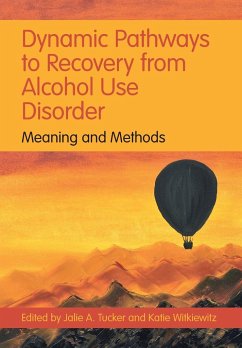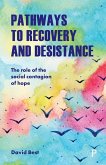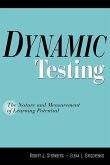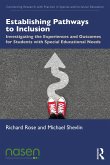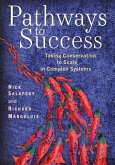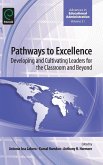Dynamic Pathways to Recovery from Alcohol Use Disorder
Herausgeber: Tucker, Jalie A.; Witkiewitz, Katie
Dynamic Pathways to Recovery from Alcohol Use Disorder
Herausgeber: Tucker, Jalie A.; Witkiewitz, Katie
- Broschiertes Buch
- Merkliste
- Auf die Merkliste
- Bewerten Bewerten
- Teilen
- Produkt teilen
- Produkterinnerung
- Produkterinnerung
This volume presents multidisciplinary research on alcohol recovery ranging from individual to community to policy influences. It pushes beyond the dominant focus on abstinence achieved via treatment and considers how recovery involves improved health and wellbeing, and the ways by which individuals, environments, and policies can support it.
Andere Kunden interessierten sich auch für
![Building Pathways to Peace Building Pathways to Peace]() Nadine Ansorg (Canterbury University of Kent)Building Pathways to Peace22,99 €
Nadine Ansorg (Canterbury University of Kent)Building Pathways to Peace22,99 €![Building Pathways to Peace Building Pathways to Peace]() Nadine Ansorg (Canterbury University of Kent)Building Pathways to Peace67,99 €
Nadine Ansorg (Canterbury University of Kent)Building Pathways to Peace67,99 €![Pathways to Recovery and Desistance Pathways to Recovery and Desistance]() David BestPathways to Recovery and Desistance39,99 €
David BestPathways to Recovery and Desistance39,99 €![Dynamic Testing Dynamic Testing]() Robert J. Sternberg (Connecticut Yale University)Dynamic Testing53,99 €
Robert J. Sternberg (Connecticut Yale University)Dynamic Testing53,99 €![Establishing Pathways to Inclusion Establishing Pathways to Inclusion]() Richard Rose (UK. University of Northhampton)Establishing Pathways to Inclusion61,99 €
Richard Rose (UK. University of Northhampton)Establishing Pathways to Inclusion61,99 €![Pathways to Success Pathways to Success]() Nick SalafskyPathways to Success41,99 €
Nick SalafskyPathways to Success41,99 €![Pathways to Excellence Pathways to Excellence]() Pathways to Excellence209,99 €
Pathways to Excellence209,99 €-
-
-
This volume presents multidisciplinary research on alcohol recovery ranging from individual to community to policy influences. It pushes beyond the dominant focus on abstinence achieved via treatment and considers how recovery involves improved health and wellbeing, and the ways by which individuals, environments, and policies can support it.
Hinweis: Dieser Artikel kann nur an eine deutsche Lieferadresse ausgeliefert werden.
Hinweis: Dieser Artikel kann nur an eine deutsche Lieferadresse ausgeliefert werden.
Produktdetails
- Produktdetails
- Verlag: Cambridge University Press
- Seitenzahl: 468
- Erscheinungstermin: 1. Dezember 2021
- Englisch
- Abmessung: 244mm x 170mm x 25mm
- Gewicht: 798g
- ISBN-13: 9781108972260
- ISBN-10: 1108972268
- Artikelnr.: 62030863
- Herstellerkennzeichnung
- Libri GmbH
- Europaallee 1
- 36244 Bad Hersfeld
- gpsr@libri.de
- Verlag: Cambridge University Press
- Seitenzahl: 468
- Erscheinungstermin: 1. Dezember 2021
- Englisch
- Abmessung: 244mm x 170mm x 25mm
- Gewicht: 798g
- ISBN-13: 9781108972260
- ISBN-10: 1108972268
- Artikelnr.: 62030863
- Herstellerkennzeichnung
- Libri GmbH
- Europaallee 1
- 36244 Bad Hersfeld
- gpsr@libri.de
Preface; Acknowledgements; Introduction; 1. Historical and contemporary
perspectives on pathways to recovery from alcohol use disorder Jalie A.
Tucker and Katie Witkiewitz; Part I. Micro Level: The Individual as Change
Agent: 2. Biopsychosocial process of change in alcohol use disorder
recovery Katie Witkiewitz and Stephen A. Maisto; 3. The role of
self-regulation strategies in recovery from alcohol use disorder Corey R.
Roos, Sarah Bowen, and Hedy Kober; 4. Neuropsychological and biological
influences on drinking behavior change Marsha E. Bates, Julianne L. Price,
Jennifer F. Buckman; 5. Lifespan developmental perspectives on natural
mechanisms of cessation of risky alcohol use and recovery from alcohol use
disorder Matthew R. Lee, Yihong Zhao, Thomas Britton, Jenna Saviano, Kaan
Kideys, Yimei Li, Colin Boulter, Emery Frick, and Kenneth J. Sher; 6.
Mutual help approaches and mechanisms of change J. Scott Tonigan; 7.
Time-Varying effect modeling to examine recovery outcomes across four years
Ashley N. Linden-Carmichael, Samuel W. Stull, Christy K. Scott, and Michael
L. Dennis; 8. Latent variable mixture modeling approaches to investigating
longitudinal recovery processes JeeWon Cheong, Adam D. Wilson, and Juhan
Lee; Part II. Meso Level: Understanding and Promoting Individual Behavior
Change Within Natural Environments: 9. Natural recovery from alcohol use
disorder: Patterns, contexts, and the behavioral economics of change Jalie
A. Tucker; 10. Individual behavioral interventions to incentivize sobriety
and enrich the natural environment with appealing alternatives to drinking
James G. Murphy, Ashley A. Dennhardt, and Kathryn S. Gex; 11. Family and
social processes in recovery from alcohol use disorder Amber M. Jarnecke,
Delisa G. Brown and Alexander J. Melkonian; 12. Community-Based harm
reduction approaches for alcohol use disorder Susan E. Collins, Seema L.
Clifasefi, Grover 'Will' Williams, Lovella Black Bear and the LEAP
Community Advisory Board; 13. Use of mobile technology to understand and
improve recovery from alcohol use disorder Matthew R. Pearson, Noah N.
Emery and Frank J. Schwebel; 14. Studying recovery in social context: A
primer on methods for measuring and modeling social network data in applied
recovery research Kevin A. Hallgren; 15. Measuring substance use contexts
and substance-free reinforcement Ali M. Yurasek, Samuel F. Acuff and
Meredith S. Berry; Part III. Macro Level: Creating Environments, Resources,
Incentives, and Policies to Promote Harm Reduction and Recovery: 16.
Recovery communities: Resources and settings David Best, Charlotte
Hargreaves, Philip Hodgson, David Patton; 17. Disparities in alcohol
treatment access in rural areas: Opportunities for change Claire
Snell-Rood, Kara Bensley and Laura Schmidt; 18. Recovery, communities, and
the organized recovery movement Robert D. Ashford; 19. Alcohol control
policy and regulations to promote recovery from alcohol use disorder
William C. Kerr and Meenakshi S. Subbaraman; 20. Causal inference
approaches to studying recovery from alcohol use disorder Douglas Steinley;
21. Building on collaborative research to co-design SURE recovery, a mobile
application for people with experience of alcohol and other drug problems
Alice Bowen, Melanie Getty, Casandra Hogan, Paul Lennon, Elle Long, John
Strang, and Joanne Neale; 22. Economic methods used to evaluate recovery
programs for alcohol use disorder Brady P. Horn; Conclusions and Future
directions; 23. Dynamic pathways to recovery from alcohol use disorder:
advancing the scientific agenda and policy priorities Katie Witkiewitz and
Jalie A. Tucker; Index.
perspectives on pathways to recovery from alcohol use disorder Jalie A.
Tucker and Katie Witkiewitz; Part I. Micro Level: The Individual as Change
Agent: 2. Biopsychosocial process of change in alcohol use disorder
recovery Katie Witkiewitz and Stephen A. Maisto; 3. The role of
self-regulation strategies in recovery from alcohol use disorder Corey R.
Roos, Sarah Bowen, and Hedy Kober; 4. Neuropsychological and biological
influences on drinking behavior change Marsha E. Bates, Julianne L. Price,
Jennifer F. Buckman; 5. Lifespan developmental perspectives on natural
mechanisms of cessation of risky alcohol use and recovery from alcohol use
disorder Matthew R. Lee, Yihong Zhao, Thomas Britton, Jenna Saviano, Kaan
Kideys, Yimei Li, Colin Boulter, Emery Frick, and Kenneth J. Sher; 6.
Mutual help approaches and mechanisms of change J. Scott Tonigan; 7.
Time-Varying effect modeling to examine recovery outcomes across four years
Ashley N. Linden-Carmichael, Samuel W. Stull, Christy K. Scott, and Michael
L. Dennis; 8. Latent variable mixture modeling approaches to investigating
longitudinal recovery processes JeeWon Cheong, Adam D. Wilson, and Juhan
Lee; Part II. Meso Level: Understanding and Promoting Individual Behavior
Change Within Natural Environments: 9. Natural recovery from alcohol use
disorder: Patterns, contexts, and the behavioral economics of change Jalie
A. Tucker; 10. Individual behavioral interventions to incentivize sobriety
and enrich the natural environment with appealing alternatives to drinking
James G. Murphy, Ashley A. Dennhardt, and Kathryn S. Gex; 11. Family and
social processes in recovery from alcohol use disorder Amber M. Jarnecke,
Delisa G. Brown and Alexander J. Melkonian; 12. Community-Based harm
reduction approaches for alcohol use disorder Susan E. Collins, Seema L.
Clifasefi, Grover 'Will' Williams, Lovella Black Bear and the LEAP
Community Advisory Board; 13. Use of mobile technology to understand and
improve recovery from alcohol use disorder Matthew R. Pearson, Noah N.
Emery and Frank J. Schwebel; 14. Studying recovery in social context: A
primer on methods for measuring and modeling social network data in applied
recovery research Kevin A. Hallgren; 15. Measuring substance use contexts
and substance-free reinforcement Ali M. Yurasek, Samuel F. Acuff and
Meredith S. Berry; Part III. Macro Level: Creating Environments, Resources,
Incentives, and Policies to Promote Harm Reduction and Recovery: 16.
Recovery communities: Resources and settings David Best, Charlotte
Hargreaves, Philip Hodgson, David Patton; 17. Disparities in alcohol
treatment access in rural areas: Opportunities for change Claire
Snell-Rood, Kara Bensley and Laura Schmidt; 18. Recovery, communities, and
the organized recovery movement Robert D. Ashford; 19. Alcohol control
policy and regulations to promote recovery from alcohol use disorder
William C. Kerr and Meenakshi S. Subbaraman; 20. Causal inference
approaches to studying recovery from alcohol use disorder Douglas Steinley;
21. Building on collaborative research to co-design SURE recovery, a mobile
application for people with experience of alcohol and other drug problems
Alice Bowen, Melanie Getty, Casandra Hogan, Paul Lennon, Elle Long, John
Strang, and Joanne Neale; 22. Economic methods used to evaluate recovery
programs for alcohol use disorder Brady P. Horn; Conclusions and Future
directions; 23. Dynamic pathways to recovery from alcohol use disorder:
advancing the scientific agenda and policy priorities Katie Witkiewitz and
Jalie A. Tucker; Index.
Preface; Acknowledgements; Introduction; 1. Historical and contemporary
perspectives on pathways to recovery from alcohol use disorder Jalie A.
Tucker and Katie Witkiewitz; Part I. Micro Level: The Individual as Change
Agent: 2. Biopsychosocial process of change in alcohol use disorder
recovery Katie Witkiewitz and Stephen A. Maisto; 3. The role of
self-regulation strategies in recovery from alcohol use disorder Corey R.
Roos, Sarah Bowen, and Hedy Kober; 4. Neuropsychological and biological
influences on drinking behavior change Marsha E. Bates, Julianne L. Price,
Jennifer F. Buckman; 5. Lifespan developmental perspectives on natural
mechanisms of cessation of risky alcohol use and recovery from alcohol use
disorder Matthew R. Lee, Yihong Zhao, Thomas Britton, Jenna Saviano, Kaan
Kideys, Yimei Li, Colin Boulter, Emery Frick, and Kenneth J. Sher; 6.
Mutual help approaches and mechanisms of change J. Scott Tonigan; 7.
Time-Varying effect modeling to examine recovery outcomes across four years
Ashley N. Linden-Carmichael, Samuel W. Stull, Christy K. Scott, and Michael
L. Dennis; 8. Latent variable mixture modeling approaches to investigating
longitudinal recovery processes JeeWon Cheong, Adam D. Wilson, and Juhan
Lee; Part II. Meso Level: Understanding and Promoting Individual Behavior
Change Within Natural Environments: 9. Natural recovery from alcohol use
disorder: Patterns, contexts, and the behavioral economics of change Jalie
A. Tucker; 10. Individual behavioral interventions to incentivize sobriety
and enrich the natural environment with appealing alternatives to drinking
James G. Murphy, Ashley A. Dennhardt, and Kathryn S. Gex; 11. Family and
social processes in recovery from alcohol use disorder Amber M. Jarnecke,
Delisa G. Brown and Alexander J. Melkonian; 12. Community-Based harm
reduction approaches for alcohol use disorder Susan E. Collins, Seema L.
Clifasefi, Grover 'Will' Williams, Lovella Black Bear and the LEAP
Community Advisory Board; 13. Use of mobile technology to understand and
improve recovery from alcohol use disorder Matthew R. Pearson, Noah N.
Emery and Frank J. Schwebel; 14. Studying recovery in social context: A
primer on methods for measuring and modeling social network data in applied
recovery research Kevin A. Hallgren; 15. Measuring substance use contexts
and substance-free reinforcement Ali M. Yurasek, Samuel F. Acuff and
Meredith S. Berry; Part III. Macro Level: Creating Environments, Resources,
Incentives, and Policies to Promote Harm Reduction and Recovery: 16.
Recovery communities: Resources and settings David Best, Charlotte
Hargreaves, Philip Hodgson, David Patton; 17. Disparities in alcohol
treatment access in rural areas: Opportunities for change Claire
Snell-Rood, Kara Bensley and Laura Schmidt; 18. Recovery, communities, and
the organized recovery movement Robert D. Ashford; 19. Alcohol control
policy and regulations to promote recovery from alcohol use disorder
William C. Kerr and Meenakshi S. Subbaraman; 20. Causal inference
approaches to studying recovery from alcohol use disorder Douglas Steinley;
21. Building on collaborative research to co-design SURE recovery, a mobile
application for people with experience of alcohol and other drug problems
Alice Bowen, Melanie Getty, Casandra Hogan, Paul Lennon, Elle Long, John
Strang, and Joanne Neale; 22. Economic methods used to evaluate recovery
programs for alcohol use disorder Brady P. Horn; Conclusions and Future
directions; 23. Dynamic pathways to recovery from alcohol use disorder:
advancing the scientific agenda and policy priorities Katie Witkiewitz and
Jalie A. Tucker; Index.
perspectives on pathways to recovery from alcohol use disorder Jalie A.
Tucker and Katie Witkiewitz; Part I. Micro Level: The Individual as Change
Agent: 2. Biopsychosocial process of change in alcohol use disorder
recovery Katie Witkiewitz and Stephen A. Maisto; 3. The role of
self-regulation strategies in recovery from alcohol use disorder Corey R.
Roos, Sarah Bowen, and Hedy Kober; 4. Neuropsychological and biological
influences on drinking behavior change Marsha E. Bates, Julianne L. Price,
Jennifer F. Buckman; 5. Lifespan developmental perspectives on natural
mechanisms of cessation of risky alcohol use and recovery from alcohol use
disorder Matthew R. Lee, Yihong Zhao, Thomas Britton, Jenna Saviano, Kaan
Kideys, Yimei Li, Colin Boulter, Emery Frick, and Kenneth J. Sher; 6.
Mutual help approaches and mechanisms of change J. Scott Tonigan; 7.
Time-Varying effect modeling to examine recovery outcomes across four years
Ashley N. Linden-Carmichael, Samuel W. Stull, Christy K. Scott, and Michael
L. Dennis; 8. Latent variable mixture modeling approaches to investigating
longitudinal recovery processes JeeWon Cheong, Adam D. Wilson, and Juhan
Lee; Part II. Meso Level: Understanding and Promoting Individual Behavior
Change Within Natural Environments: 9. Natural recovery from alcohol use
disorder: Patterns, contexts, and the behavioral economics of change Jalie
A. Tucker; 10. Individual behavioral interventions to incentivize sobriety
and enrich the natural environment with appealing alternatives to drinking
James G. Murphy, Ashley A. Dennhardt, and Kathryn S. Gex; 11. Family and
social processes in recovery from alcohol use disorder Amber M. Jarnecke,
Delisa G. Brown and Alexander J. Melkonian; 12. Community-Based harm
reduction approaches for alcohol use disorder Susan E. Collins, Seema L.
Clifasefi, Grover 'Will' Williams, Lovella Black Bear and the LEAP
Community Advisory Board; 13. Use of mobile technology to understand and
improve recovery from alcohol use disorder Matthew R. Pearson, Noah N.
Emery and Frank J. Schwebel; 14. Studying recovery in social context: A
primer on methods for measuring and modeling social network data in applied
recovery research Kevin A. Hallgren; 15. Measuring substance use contexts
and substance-free reinforcement Ali M. Yurasek, Samuel F. Acuff and
Meredith S. Berry; Part III. Macro Level: Creating Environments, Resources,
Incentives, and Policies to Promote Harm Reduction and Recovery: 16.
Recovery communities: Resources and settings David Best, Charlotte
Hargreaves, Philip Hodgson, David Patton; 17. Disparities in alcohol
treatment access in rural areas: Opportunities for change Claire
Snell-Rood, Kara Bensley and Laura Schmidt; 18. Recovery, communities, and
the organized recovery movement Robert D. Ashford; 19. Alcohol control
policy and regulations to promote recovery from alcohol use disorder
William C. Kerr and Meenakshi S. Subbaraman; 20. Causal inference
approaches to studying recovery from alcohol use disorder Douglas Steinley;
21. Building on collaborative research to co-design SURE recovery, a mobile
application for people with experience of alcohol and other drug problems
Alice Bowen, Melanie Getty, Casandra Hogan, Paul Lennon, Elle Long, John
Strang, and Joanne Neale; 22. Economic methods used to evaluate recovery
programs for alcohol use disorder Brady P. Horn; Conclusions and Future
directions; 23. Dynamic pathways to recovery from alcohol use disorder:
advancing the scientific agenda and policy priorities Katie Witkiewitz and
Jalie A. Tucker; Index.

